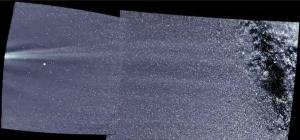One Year, 2 Trips Around Sun for NASA's Parker Solar Probe
Since NASA's Parker Solar Probe launched on Aug. 12, 2018, Earth has made a single trip around the Sun — while the daring solar explorer is well into its third orbit around our star. With two close passes by the Sun already under its belt, Parker Solar Probe is speeding toward another close solar approach on Sept. 1, 2019.

Parker Solar Probe's WISPR instrument saw the solar wind streaming past during the spacecraft's first solar encounter in November 2018.
Parker Solar Probe is named for Eugene Parker, the physicist who first theorized the solar wind — the constant outflow of particles and magnetic fields from the Sun — in 1958. Parker Solar Probe is the first NASA mission to be named for a living person.
In the year since launch, Parker Solar Probe has collected a host of scientific data from two close passes by the Sun.
"We're very happy," said Nicky Fox, director of NASA's Heliophysics Division at NASA Headquarters in Washington, D.C. "We've managed to bring down at least twice as much data as we originally suspected we’d get from those first two perihelion passes."
The spacecraft carries four suites of scientific instruments to gather data on the particles, solar wind plasma, electric and magnetic fields, solar radio emission, and structures in the Sun's hot outer atmosphere, the corona. This information will help scientists unravel the physics driving the extreme temperatures in the corona — which is counterintuitively hotter than the solar surface below — and the mechanisms that drive particles and plasma out into the solar system.
Parker Solar Probe's WISPR instrument captures images of solar wind structures as they stream out from the Sun, allowing scientists to connect them with Parker's in situ measurements from its other instruments.
This video, which spans Nov. 6-10, 2018, combines views from both WISPR telescopes during Parker Solar Probe's first solar encounter. The Sun is out of frame past the combined image's left side, so the solar wind flows from left to right past the view of the telescopes. The bright structure near the center of the left edge is what's known as a streamer — a relatively dense, slow flow of solar wind coming from the Sun — originating from near the Sun's equator.
The video appears to speed up and slow down throughout the movie because of the ways data is stored at different points in Parker Solar Probe's orbit. Near perihelion, the closest approach to the Sun, the spacecraft stores more images — and more frames for a given section make the video appear to slow down. These images have been calibrated and processed to remove background noise.
The Milky Way's galactic center is visible on the right side of the video. The planet visible on the left is Mercury. The thin white streaks in the image are particles of dust passing in front of WISPR's cameras.
The mission team is currently in the process of analyzing data from Parker Solar Probe's first two orbits, which will be released to the public in 2019.
"The data we’re seeing from Parker Solar Probe’s instruments is showing us details about solar structures and processes that we have never seen before,” said Nour Raouafi, Parker Solar Probe project scientist at the Johns Hopkins Applied Physics Laboratory, which built and operates the mission for NASA. “Flying close to the Sun — a very dangerous environment — is the only way to obtain this data, and the spacecraft is performing with flying colors.”
Source: U.S. National Aeronautics and Space Administration
- 221 reads
Human Rights
Ringing FOWPAL’s Peace Bell for the World:Nobel Peace Prize Laureates’ Visions and Actions

Protecting the World’s Cultural Diversity for a Sustainable Future

The Peace Bell Resonates at the 27th Eurasian Economic Summit

Declaration of World Day of the Power of Hope Endorsed by People in 158 Nations

Puppet Show I International Friendship Day 2020

